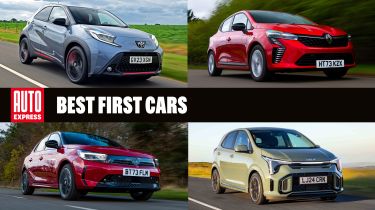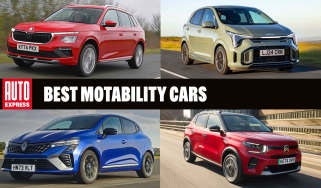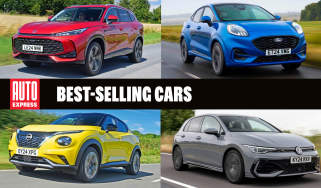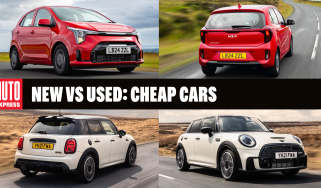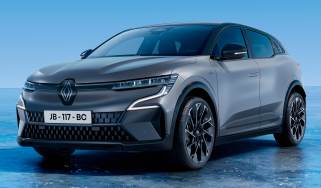Best first cars for new drivers 2025
These are the best cars for first time drivers, all of which are cheap, easy to drive and safe
Once you've passed your practical driving test and got your driving licence, the next barrier between you and a whole new level of freedom is finding your first car. The best first cars offer a combination of safety, equipment, practicality, and easy manoeuvrability, not to mention being some of the cheapest cars to insure. To help make your search as easy as possible, our experts have rounded up the very best first cars for new drivers right here.
The cost of buying and running a car can be steep, especially for new drivers, so we’ve chosen these cars with their value for money, reliability and fuel economy at the forefront of our minds. Naturally, our picks also offer cheap car insurance for young drivers.
All of these models are brand new, but many great examples can also be found on the used market for lower prices. Either way, they are all available for a reasonable price, particularly if you finance them through a Personal Contract Purchase (PCP) finance agreement or a Personal Contact Hire (PCH) leasing deal.
Compare the best first cars for new drivers
You can compare our in-depth review star ratings for the top 10 first cars for new drivers using the table below, along with the . Scroll down for the full story on each car…
| Best first cars ranking | Name | Prices from | Efficiency and running costs rating (out of 5) | Overall Auto Express star rating (out of 5) | Fuel types | Max. WLTP combined efficiency | Boot space |
| 1 | Skoda Fabia | £20,295 | 4 | 4 | Petrol | 55.4mpg | 380 litres |
| 2 | Kia Picanto | £15,845 | 4 | 4 | Petrol | 54.3mpg | 255 litres |
| 3 | Hyundai i10 | £15,880 | 4.2 | 4 | Petrol | 55.3mpg | 252 litres |
| 4 | Toyota Aygo X | £16,140 | 3.5 | 3.5 | Petrol | 58.9mpg | 231 litres |
| 5 | Volkswagen Polo | £21,210 | 4 | 4 | Petrol | 54.3mpg | 351 litres |
| 6 | Dacia Sandero | £14,200 | 4.4 | 4 | Petrol | 53.3mpg | 328 litres |
| 7 | Leapmotor T03 | £15,995 | 4.0 | 4.0 | Electric | 165 miles | 210 litres |
| 8 | Renault Clio | £18,595 | 4.5 | 4.5 | Petrol/hybrid | 54.3/67.3mpg | 391 litres |
| 9 | Vauxhall Corsa | £18,505 | 3.5 | 3.5 | Petrol/mild-hybrid/electric | 55.4mpg/62.8mpg/221 miles | 267-309 litres |
| 10 | Fiat 500e | £24,995 | 4 | 4 | Electric | 193 miles | 185 litres |
1. Skoda Fabia

- Prices from £20,300
- Best first car for new drivers overall
Pros |
Cons |
| Interior space | No hybrid model |
| Decent on-board tech | Road noise at higher speed |
| Comfortable | Not particularly fun to drive |
First-time drivers need a car that’s easy to drive, cheap to insure and affordable to buy, and the car that manages to blend all of these things together best of all is the Skoda Fabia.
The Fabia doesn't come with the option of hybrid or electric power, but all three of the petrol engines on offer can easily surpass 45mpg, so you won’t be spending a fortune at the pumps. New drivers will be best served by the entry-level 1.0 MPI engine as this whittles the Skoda Fabia down to insurance group four, making it one of the cheapest cars to insure in the UK.
This engine produces a modest 79bhp, so it does have to work quite hard in order to reach motorway cruising speeds, but what it lacks in performance is more than made up for in efficiency. The soft suspension setup means longer journeys will be comfortable, too, although we didn’t find the Fabia as much fun to drive as rivals like the MINI Cooper or Renault Clio on our tests.
If you’re not fussed about the fun factor, though, the Fabia gets the sensible stuff more or less spot on. As well as its low running costs, the latest Fabia manages to feel like a bigger car than it actually is, and it’s actually the largest Fabia yet. The 380-litre boot is the same size as you’ll find in the larger Volkswagen Golf, so family car duties won’t be out of the question. The cabin also feels very well screwed together, and the Czech brand hasn’t been too stingy with its standard kit.

“The Fabia has fine-tuned what was already a pretty compelling package into one of the best superminis you can buy”. - Ellis Hyde, news reporter, who tested the Fabia in the UK
Alternatives to the Skoda Fabia include its own VW Group stablemates; the SEAT Ibiza and Volkswagen Polo which use similar technology. The Ibiza is arguably the more stylish of the three but the Fabia has the edge over both cars when it comes to overall practicality. Another option is the Hyundai i20, but this comes with a higher starting price than the Skoda.
2. Kia Picanto
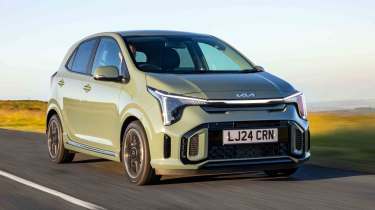
- Prices from £16,100
Pros |
Cons |
| Good to drive | 1.0 engine is slow |
| Big-car kit list | 1.2 is only available in pricier trims |
| Spacious and well-made | The bigger Dacia Sandero is cheaper |
The Kia Picanto has grown into an attractive little city car over the years, but it hasn’t lost sight of its low-cost roots. The Picanto is one of the smallest brand-new cars you can currently buy, and it comes with some equally compact costs. The entire line-up sits between groups three and seven, so you shouldn’t be forking out any more than is absolutely necessary on those dreaded premiums. Every variant can also return over 50mpg.
When it comes to powering the Picanto, none of the petrol engines are particularly punchy, but we didn’t struggle to keep up with traffic during testing. As you’d expect from a car of this size, driving and parking is a breeze for even the most novice of drivers, and the little Kia’s modest kerb weight and quick steering means there’s some fun to be had, too, albeit at sensible speeds. Reliability shouldn’t be too much of a concern, either, as Kia’s renowned seven-year/100,000-miles warranty is thrown in as standard.
Thanks to some clever engineering, the latest Kia Picanto makes the most of the limited interior space that it’s able to offer. You’ll be able to seat four adults within the Picanto, but you may all wish to take a few breaks on longer journeys due to the seats feeling rather firm. If you need to carry smaller passengers, there’s also a pair of ISOFIX points in the back. Even the base ‘2’ model is fitted with its fair share of useful kit, too, such as an 8-inch touchscreen infotainment system, air-conditioning, all-round electric windows and 14-inch alloy wheels.

“The latest Kia Picanto has gone through a significant glow-up, transformed from the drab and sparse first-generation car.” - Ellis Hyde, news reporter, who tested the Picanto in the UK
The city car market is smaller than it used to be, and the most obvious alternative to the Kia Picanto is its own sister car, the Hyundai i10, which has slightly less style about it. A number of other city cars are now fully-electric, so if you’d rather cut out your emissions, the Dacia Spring and Leapmotor T03 are available for similar money. You can find more options in our list of the best small electric cars…
3. Hyundai i10
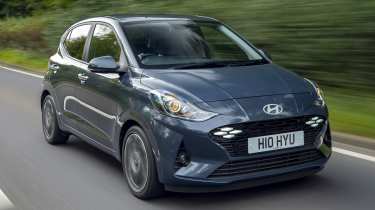
- Prices from £16,400
- Best for comfort
Pros |
Cons |
| Decent on-board tech | Automatic gearbox |
| Roomy cabin | Lacklustre base engine |
| Smart looks | Dull interior |
The Hyundai i10 is a small car with plenty of big car qualities, but the biggest highlight is that it’s available with the coveted group one insurance rating,
If you want this increasingly rare rating, you’ll need to choose the automatic i10 in Advance trim. Unfortunately this gearbox is pretty jerky in operation, but the more pleasant five-speed manual is accompanied by a higher insurance premium. Regardless of which gearbox you decide to opt for, though, the i10 is a frugal machine. Both the 1.0-litre and 1.2-litre engines sit firmly north of the 50mpg figure, and this achievable in the real world, too, as we managed an average of 53.1mpg when testing a 1.2-litre model in Premium trim.
It’s a bit more subdued to look at than the closely-related Kia Picanto, and the Hyundai i10 feels a little bit more grown up from behind the wheel, too. The ride is easily one of the most comfortable in the city car class, to the point where we’d be happy to use the i10 on a long-distance commute. The light steering and minimal power means thrills are few and far between, but driving and parking should prove stress free every time.
To accompany its sophisticated driving experience and smart appearance, all i10s are very well equipped. Entry-level Advance trim comes with 15-inch alloy wheels, air-conditioning, an eight-inch touchscreen with Apple CarPlay and Android Auto, rear parking sensors, a reversing camera and cruise control.
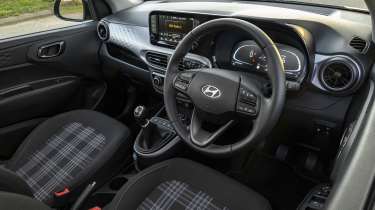
“Hyundai’s smallest car is more comfortable and refined than ever, while the diminutive size, tight turning circle and light steering make it an absolute doddle to drive around town.” - Ellis Hyde, news reporter, who tested the i10 in the UK
As they are so closely related, the Hyundai i10 faces the same rivals as the Kia Picanto. If you’d prefer a bit more space for your money, though, you could consider a larger supermini such as the Suzuki Swift, Vauxhall Corsa or Dacia Sandero.
4. Toyota Aygo X
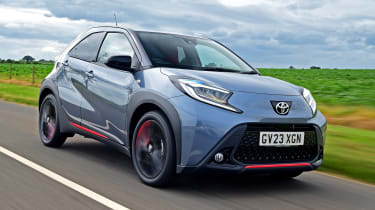
- Prices from £16,900
Pros |
Cons |
| Beefy looks | Rear cabin space |
| Well equipped | Dated interior |
| Convertible option | Same money as larger superminis |
The Toyota Aygo X is a funky, pseudo-SUV with city car costs, although it does cost more to buy than a number of rivals.
While the Aygo X’s thrummy little three-cylinder engine is a bit old-school compared to an ever-increasing number of hybrid and fully-electric small cars, it does have plenty of character. Its modest power output helps to keep insurance premiums and fuel consumption under control, too.
On the outside, chunky plastic cladding on the wheelarches and 17-inch alloy wheels give the Toyota an upright stance, but its 3.7-metre length still enables it to squeeze into the tightest of parking spots. The standard-fit reversing camera means that there’s less chance of unintended bumps, too.
Take a step inside and some body-coloured splashes on the insides of the doors add a bit of charm to the cabin, while the central touchscreen features Apple CarPlay and Android Auto. It isn’t quite as refined or as spacious as the Kia Picanto or Hyundai i10, but there’s still plenty to like.
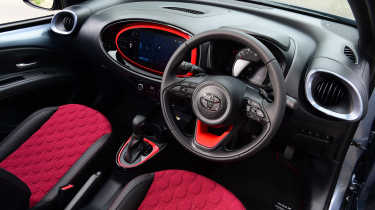
“Funky looks and a sense of fun give the tiny Toyota a certain appeal, and set it apart from the more grown-up contenders in this class.” - Ellis Hyde, news reporter, who tested the Aygo X in the UK
The Aygo X is quite a unique car in its appearance, and one of the only other cars that could have been considered as a close rival was the Suzuki Ignis. However, this car is no longer being produced, so the remaining alternatives are more conventional city cars like the Kia Picanto and Hyundai i10. Our list of the best city cars will give you even more options.
5. Volkswagen Polo
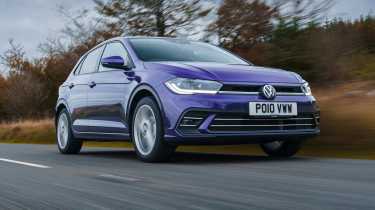
- Prices from £21,500
Pros |
Cons |
| High quality interior | Not the most fun to drive |
| Composed ride | Expensive for a supermini |
| Interior space | Disappointing GTI model |
If what you desire is a ‘grown-up’ supermini, the Volkswagen Polo is very hard to beat.
Being closely related to the Skoda Fabia mentioned higher up in this list, the Polo is another supermini with a sense of distinction about it. Provided you steer clear of the hot Polo GTI (tempting as it may be) you won’t have to fork out loads on running VW’s baby hatch, either. Opt for the base ‘Life’ model and you’ll be looking at a car that sits in insurance group three.
Comfort and refinement are the Polo’s best qualities on the move, rather than sportiness. We recommend avoiding the optional sports suspension or larger alloy wheels as these take away from the Polo’s soft nature without really adding anything apart from cosmetic tweaks. The Polo GTI is the one for the sporting enthusiast (and the variant with the highest costs), but the standard models are a great choice for those who simply want a sturdy, sensible and practical car that’s unimposing to drive. That being said, there is always the option of the Driver Assistance Package which includes parking assist.
The current Polo is notably larger than previous generations, and there’s genuinely plenty of space for four adults. The 351-litre boot is slightly smaller than the Fabia’s, but it should still be enough for the weekly shop and occasional tip run.
There are a few trim levels to choose from, but the base ‘Life’ trim offers plenty of features including alloy wheels, automatic headlights, a DAB radio, electronic stability control, and rain-sensing automatic wipers.
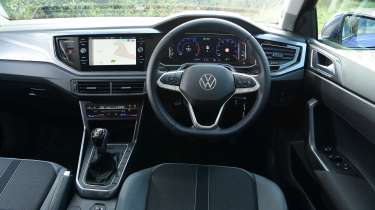
“Buy a Polo, and you’ll be getting into a small car that rides with a similar level of composure to a VW Golf, while the interior quality is impressive” - Ellis Hyde, news reporter, who tested the Aygo X in the UK
There are a greater number of superminis to choose from than there are city cars, so there are numerous VW Polo alternatives to choose from. The MG3 and Suzuki Swift are both priced from under £20,000, so these are particularly budget friendly. Our best superminis to buy list features even more alternatives.
6. Dacia Sandero
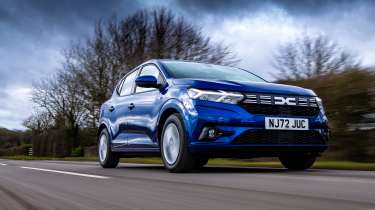
- Prices from £14,800
- Best value for money
Pros |
Cons |
| Cabin quality | Jerky power delivery on TCe |
| Better to drive | Cabin noise |
| Price | Two-star Euro NCAP rating |
The Dacia Sandero is one of the cheapest cars to buy in the UK, and the latest-generation model is based on the current Renault Clio, which itself is a great supermini.
As a new driver, you may wish to focus on the basics as you get used to driving without an instructor sitting next to you. The Sandero is a great choice for no-nonsense motoring as it simply offers the features that drivers need for a price they can genuinely afford. A brand-new Sandero can be yours for under £15,000, and you can find plenty of bargains on the used car market, too.
Being based on the Renault Clio means the latest Sandero is far more engaging to drive than its humble appearance might suggest. While our expert road testers weren’t exactly grinning from ear-to-ear due to white-knuckle thrills, the Sandero does a respectable job of remaining composed when cornering at reasonably higher speeds. The 10.5-metre turning circle also makes manoeuvring a breeze, and this all but eliminates the need for awkward three-point turns.
The Dacia Sandero should also prove practical for everyday use, with five seats, five doors and a 320-litre boot. Admittedly, equipment is fairly sparse compared to some of the other cars on this list, but the essentials are still there, including air-conditioning and cruise control. Build quality has also taken a huge step forward compared to the previous model.
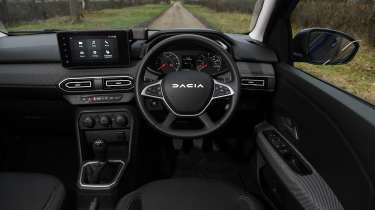
“The Dacia Sandero continues to offer great practicality for cost-conscious buyers.” - Ellis Hyde, news reporter, who tested the Sandero in the UK
The Sandero is one of the cheapest cars in the UK, so you’ll struggle to find an alternative without forking out more cash. However, if you want a small car that’s even cheaper to run, you could consider the fully-electric Dacia Spring which starts from £14,995.
7. Leapmotor T03
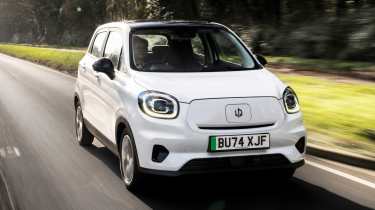
- Prices from £16,000
- Best for running costs
Pros |
Cons |
| Plenty of rear seat interior space for a city car | Tiny boot and one-piece folding back seat impact practicality |
| Lots of equipment as standard | Bouncy ride quality compared with more accomplished rivals |
| Represents good value compared with rivals | Some cheap-feeling interior materials |
Leapmotor is a newcomer to the UK market, but the T03 is one of the cheapest electric cars on sale.
The electric car market is growing fast, and prices are continuing to head downwards. This means that new drivers can now join the roads without touching a drop of liquid fuel, if they wish to. The Leapmotor T03 is a compact electric city car that also happens to be one of the cheapest electric cars on sale at around £16,000. One of the biggest advantages of EVs are reduced running costs, including cheaper road tax and the avoidance of emissions-based charging.
If you’re already clued up on EVs, you may know that the similarly-sized Dacia Spring can be bought for around £1,000 less than the T03. However, we’re recommending the Leapmotor here because it offers 165 miles of range on the WLTP combined cycle, which is more than the Dacia’s 140-mile maximum. The T03 is also more powerful than its arch-rival with 95bhp and 158Nm of torque on tap, but it’s still not exactly a performance machine. That being said, it’s a perfectly simple car to get on with on city streets, and it’s not out of its depth on the occasional motorway run.
The Leapmotor is a very compact car by modern standards, so the level of practicality on offer is best described as mediocre. The T03 comes with five doors as standard, so it’s easier to get in and out of than the likes of the Fiat 500e, and two adults will just about be able to fit in the back seats. The Dacia Spring wins the boot space stakes with 308 litres compared to the Leapmotor’s 210 litres, but the latter’s rear seats can be folded in order to increase this capacity.
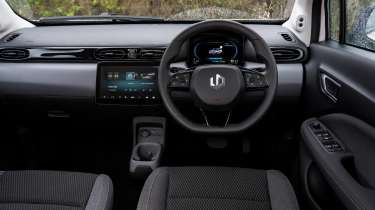
“The Leapmotor T03 is a credible alternative to the Dacia Spring, and should win fans on its lavish amount of standard equipment alone.” - Richard Ingram, deputy editor, who tested the T03 in the UK
As we’ve mentioned, the most direct alternative to the Leapmotor T03 is the Dacia Spring, which starts from £1,000 less but also offers fewer miles of range. If you don’t mind spending a bit more, you could bag a Citroen e-C3 (our reigning Car of the Year) for under £23,000.
8. Renault Clio
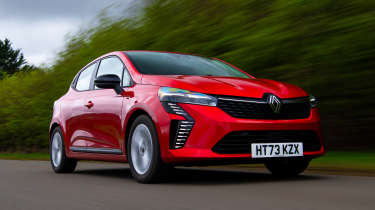
- Prices from £19,000
Pros |
Cons |
| Striking new look | Rear space is a little tight |
| Lots of equipment | Noisy petrol in hybrid models |
| Great to drive | Slow pure-petrol version |
If you’re something of a fashionista, the latest Renault Clio should suit you as it’s one of the best-looking superminis that you can currently buy.
Of course, beauty is only skin deep, but we’re pleased to report that the Clio has plenty of substance to go with its style. Buyers have the choice of petrol or hybrid power, but both offer pleasingly high fuel efficiency on the WLTP combined cycle — up to 54.3mpg for the petrol and rising to 67.3mpg for the hybrid. Insurance, meanwhile, starts from group 10.
With its pleasant steering and composed suspension, the Renault Clio is one of the more enjoyable superminis to drive (especially since the demise of the Ford Fiesta), although neither the petrol nor hybrid models are particularly quick. Those who do opt for the hybrid will enjoy the instant acceleration of electric motors before the petrol engine kicks in at around 20mph.
The Clio’s cabin is perhaps a bit more straightforward than its exterior appearance might suggest, but it’s still a pleasant enough place to sit. The controls all fall to hand nicely and we found the infotainment system pretty easy to fathom and operate, even if it isn’t Renault’s latest tech.
If you’re someone who enjoys their space, you’ll be better served by the petrol-powered Clio, as this boasts a 391-litre boot, which is by far one of the biggest in the supermini class. The hybrid still offers a respectable 301 litres, but this falls short of some rivals including the Skoda Fabia, Hyundai i20 and SEAT Ibiza.
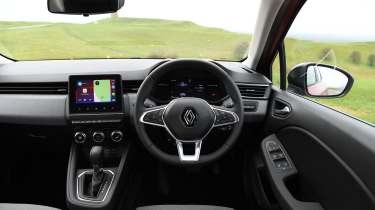
“The Renault Clio refuses to relinquish its position as one of the best superminis on the market.” - Ellis Hyde, news reporter, who tested the Sandero in the UK
As has been the case for a few decades now, the Vauxhall Corsa remains a stubborn thorn in the Renault Clio’s side (although it’s arguably less appealing to look at). If you’re considering a hybrid, the Toyota Yaris and Honda Jazz are two of the most efficient superminis you can currently buy.
9. Vauxhall Corsa
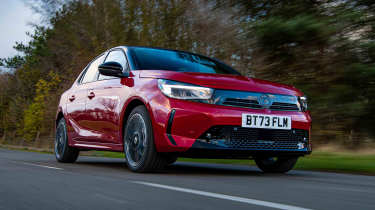
- Prices from £18,500
Pros |
Cons |
| Great engines | Tight rear space |
| Slicker infotainment | The ride never fully settles |
| Refinement | Electric model is expensive to buy |
You may well have learned how to get your driving licence by taking lessons in a Vauxhall Corsa as it’s so popular with driving instructors. If so, this supermini will come with a sense of familiarity.
It may be one of the UK’s best-selling cars, but the Vauxhall Corsa has another ace up its sleeve; you can choose petrol, mild-hybrid or fully-electric power. Naturally, if you’re prepared to make the switch, the Vauxhall Corsa Electric offers the lowest running costs and emissions. However, the petrol and mild-hybrid cars will return between 50 to 63 mpg on paper, so they’re not exactly thirsty, either. Regardless, if you want the lowest purchase price then you’ll need to look at the petrol-powered model.
The driving experience is pretty much the same across the Corsa line-up, and all models felt reasonably spritely when we put our right foot to the floor. This supermini’s light weight also means it feels agile in corners and doesn’t need to be thrashed in order to reach motorway speeds. The steering is noticeably light, but this does make for easy parking.
One area where the Vauxhall falls some way short of the competition, though, is when it comes to interior space. Before we even set foot inside our test car, we found the door opening to be surprisingly narrow, making the Corsa a bit tricky to get in and out of. Once eventually inside, the cabin feels generally cramped, and the 309-litre boot seems comparatively tiny compared to the petrol-powered Renault Clio. The Corsa Electric’s boot is even smaller at just 267 litres.
In terms of standard kit, every trim level gets a reasonable amount including alloy wheels, LED lighting and a 10-inch touchscreen with Apple CarPlay and Android Auto. The infotainment software is also a big upgrade over the systems found in Corsas of the past.
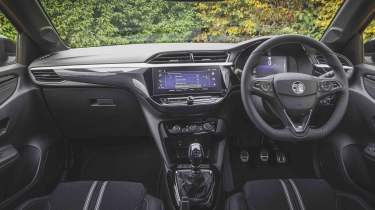
“The Corsa is more convincing than ever thanks to its impressive blend of performance, high fuel economy, decent comfort, and easy-to-drive manners.” - Max Adams, online reviews editor, who tested the Corsa in the UK
Now that the Ford Fiesta is no more, the Renault Clio is now leading the way as the long-standing alternative to the Corsa. Another French car to consider is the Peugeot 208, which shares a number of components with the Vauxhall.
10. Fiat 500e
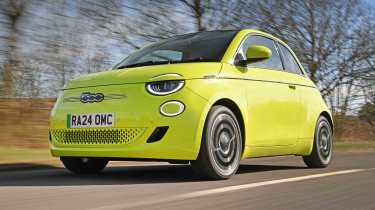
- Prices from £25,000
Pros |
Cons |
| Great to drive in urban areas | Heavy depreciation from list price |
| Excellent energy efficiency | No rear doors limits cabin access |
| Stylish interior design stands out | Very light and vague steering |
The Fiat 500e is arguably more fashionable than some of the other cars on this list, but this glamour comes at an additional cost.
£25,000 isn’t exactly small change for a new driver, and that’s just the starting price, but if you can afford it, the Fiat 500e is such a good little EV that we named it our City Car of the Year twice. Not to be confused with the older Fiat 500, this car is only available as an EV, so you could save a fair amount of cash — especially if you’re able to charge at home and have a dedicated electricity tariff. Insurance could be a hurdle, though, as the 500e line-up sits between groups 16 to 18.
The Fiat’s official WLTP combined battery range sits between 118 and 193 miles, depending on your chosen battery and spec, and neither of these numbers are particularly groundbreaking. However, if you’re only planning to use the 500e for shorter journeys, this car thrives in lower speed, urban scenarios. It takes up very little space, offers outstanding all-round visibility and the power delivery is responsive yet predictable.
It may come as no surprise to hear that the downside of such a compact car is limited room inside. As charming as the Fiat 500e’s cabin is, your rear passengers won’t be too eager to be there for long due to the restricted headroom. Taller drivers will also find themselves in a similar situation. The driver’s seat is adjustable in some variants but we recommend trying before you buy.
Accompanying this chic interior is a healthy dose of up-to-date on-board tech. A 10.25-inch touchscreen sits in the middle of the dash while the driver is presented with a round seven-inch information display. Fork out for a top-spec 500e and this will even come with semi-autonomous driving tech.
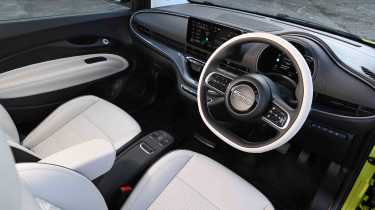
“As a city car the 500e certainly cuts it with the best, although its limitations are easy to see once you head out on the open road.” - Alex Ingram, chief reviewer, who tested the 500e in the UK
If you desire a small, retro electric car that isn’t a Fiat 500e, the most obvious choice is the MINI Cooper E. Both cars are similarly priced, but the MINI has the edge when it comes to interior space and battery range.
What to look for in a first car
Here are some key questions to ask when shopping for a first car…
Is it cheap to insure?
One of the biggest obstacles for new drivers to overcome is sky-high insurance costs. As a new driver, your shortage of experience will count against you in the eyes of an insurer. If you can keep out of trouble for 12 months, you will accrue a no-claims discount which will give you a percentage reduction on your premium. If you continue to not make any insurance claims, then this discount will only grow over the years. There are even some finance deals which include free insurance, although this usually raises the monthly payments drastically.
One way of boosting a no-claims discount is to fit your car with an insurer-approved 'black box'. This electronic device plugs into your car's electronics and monitors your driving, and you and your insurer can review your performance to see how and where you can improve. Return a good score, and the insurer can further reduce your payments.
Is it safe?
Some parents will be in a position to buy their children their first car, and if you're in that enviable situation, then you'll likely want to buy the safest car possible. You need to find the cars that come with the highest Euro NCAP safety rating: the higher the score for a car, the safer it is.
Still, buying a new car rather than an old second-hand one will mean it's inherently safer, because it will feature the most up-to-date safety equipment. This could include more advanced systems such as autonomous emergency braking and lane-keeping assist, which allow the car’s systems to intervene in an emergency and try to avoid a collision.
Which fuel type should I choose?
We'd recommend going for a petrol car over a diesel. There aren't many small diesel cars on sale these days, and you'll only reap the benefit of their better fuel consumption if you do lots of motorway miles, which is unlikely if you're an inexperienced driver.
It's better to go for a small petrol, and if the option of stop-start is available then that should help to reduce running costs even more. While the experience of the engine cutting out when you put the car in neutral might be unnerving at first, you'll soon get into the habit of saving fuel and making your money go further.
Alternatively, if your budget allows, an increasing number of smaller hybrid models are going on sale. These cars use both a petrol engine and electric motors to lower fuel consumption and emissions, meaning that you could make savings on both running costs, all while reducing your carbon footprint. If you are looking at a hybrid car, it is important to remember that there are different types of hybrid, and these carry their own advantages and disadvantages depending on how you use them.
If you’d prefer to go all-electric, there are lots of small, easy-to-drive models to choose from. However, prices for electric cars are still higher than their petrol, diesel and hybrid counterparts in the majority of cases, and insurance premiums can be a lot higher. Calculate it correctly, and the fuel and tax savings could help to counteract this. It is, of course, important to make sure that you would indeed be able to live with an electric car, such as having the space for a home-charger.
Is it easy to drive?
Other important things to look out for when buying a car for a new driver include light steering, good visibility, a responsive engine and brakes, user-friendly controls and a positive gear shift; all of these will help a new driver build confidence during their time behind the wheel. You’ll want to take a few test drives in the models on your first car shortlist to decide which one suits you best.
Keep reading to find everything you need to know about learning to drive, getting your driving licence and choosing your first car...
Learning to drive
Passing your driving test
- Driving theory test: everything you need to know
- Hazard perception test: what to expect and how to pass
- Driving test 'show me, tell me' questions: hints and tips
- Practical driving test: how to pass
- Driving test pass rates explained
- Driving test aids product test
- History of the UK driving test

